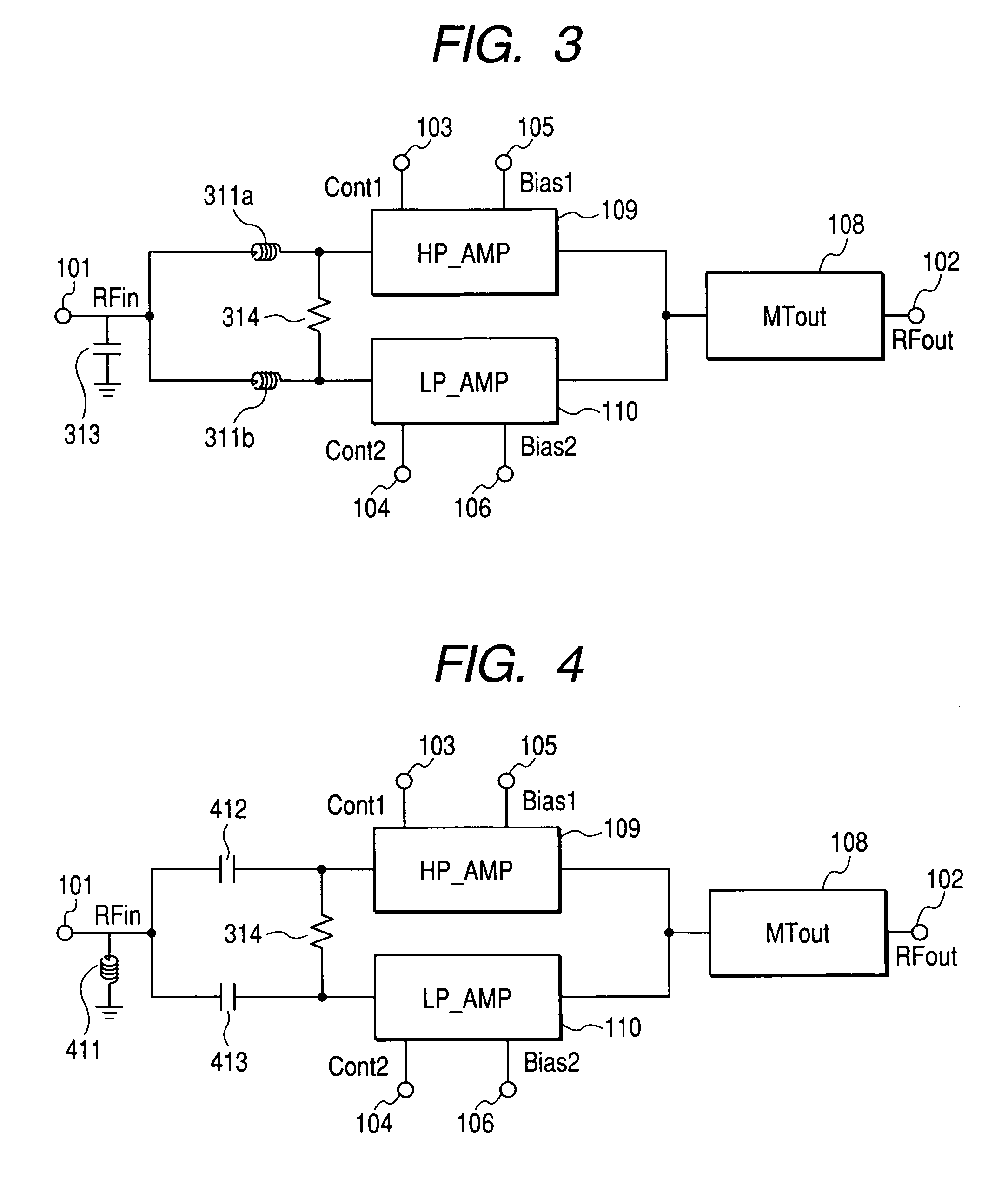High-frequency power amplifier module
a power amplifier and high-frequency technology, applied in gated amplifiers, amplifiers with semiconductor devices only, amplifiers with semiconductor devices, etc., can solve the problems of less stable amplifiers, and achieve low isolation between the amplifiers, lowering operation efficiency, and reducing the effect of operational efficiency
- Summary
- Abstract
- Description
- Claims
- Application Information
AI Technical Summary
Benefits of technology
Problems solved by technology
Method used
Image
Examples
embodiment 1
[0022]FIG. 1 is a circuit block diagram showing a configuration of a high-frequency power amplifier module according to the present invention. A high-frequency power is input to a high-frequency input (RFin) terminal 101 and is transmitted, via a high-isolation, input matching circuit (HISO_MTin) 107, to a high-power amplifier section (HP_AMP) 109 or a low-power amplifier section (LP_AMP) 110 to be amplified there. The amplified high-frequency power is then output, after passing an output matching circuit (MTout) 108, from a high-frequency output (RFout) terminal 102. The high-isolation input matching circuit may be, for example, a Wilkinson divider.
[0023]Activating the low-power amplifier section 110 and deactivating the high-power amplifier section 109 of the high-frequency power amplifier module is possible by turning off either or both of a bias input terminal (Cont1) 103 and a bias output terminal (Bias1) 105 of the high-power amplifier section 109 and turning on both of a bias...
embodiment 2
[0028]FIG. 2 is a circuit block diagram showing a configuration of a high-frequency power amplifier module according to a second embodiment of the present invention. The configuration is the same as the configuration shown in FIG. 1 with the high-isolation input matching circuit 107 replaced by a distributed constant Wilkinson circuit.
[0029]In this embodiment, distributed constant lines (MSLs) 212 and 213 and a resistance 214 make up the distributed constant Wilkinson circuit. In this case, it is not necessarily required that either or both of the line impedance and the electrical length are the same between the distributed constant lines 212 and 213. In other words, impedances and / or distributions at Wilkinson divider terminals may be different for the low-power amplifier section 110 and the high-power amplifier section 109.
[0030]This is because the amplification gain or the input impedance is not necessarily the same between the high-power amplifier section 109 and the low-power a...
embodiment 3
[0032]FIG. 3 is a circuit block diagram showing a configuration of a high-frequency power amplifier module according to a third embodiment of the present invention. The configuration is the same as the configuration shown in FIG. 1 with the high-isolation input matching circuit 107 replaced by a lumped constant Wilkinson circuit. In this embodiment, inductances 311a and 311b, a capacitance 313, and a resistance 314 make up the lumped constant Wilkinson circuit. In this case, the inductances 311a and 311b need not necessarily be of a same value. A high-frequency power is input to the high-frequency input terminal 101 and is transmitted, via the lumped constant Wilkinson circuit, to the high-power amplifier section 109 or the low-power amplifier section 110. The subsequent operation is the same as in the configuration shown in FIG. 1. The effects of this embodiment are also similar to those obtained from the configuration shown in FIG. 1.
PUM
 Login to View More
Login to View More Abstract
Description
Claims
Application Information
 Login to View More
Login to View More - R&D
- Intellectual Property
- Life Sciences
- Materials
- Tech Scout
- Unparalleled Data Quality
- Higher Quality Content
- 60% Fewer Hallucinations
Browse by: Latest US Patents, China's latest patents, Technical Efficacy Thesaurus, Application Domain, Technology Topic, Popular Technical Reports.
© 2025 PatSnap. All rights reserved.Legal|Privacy policy|Modern Slavery Act Transparency Statement|Sitemap|About US| Contact US: help@patsnap.com



